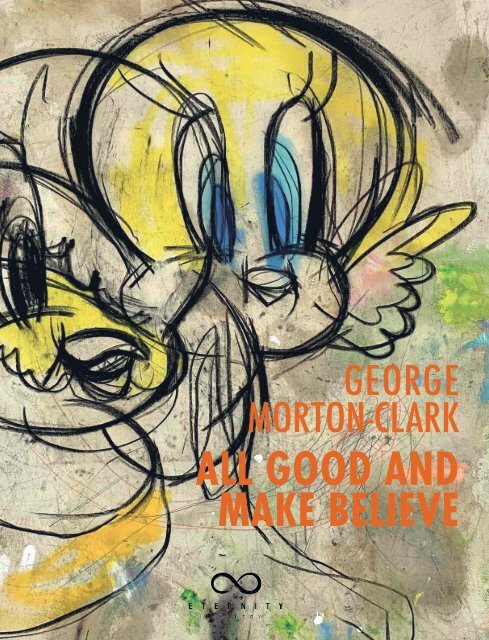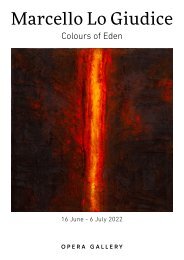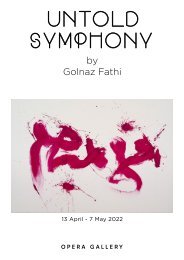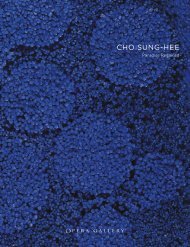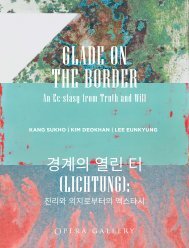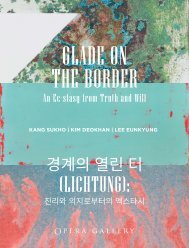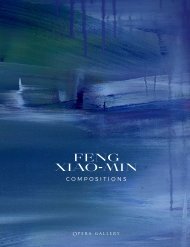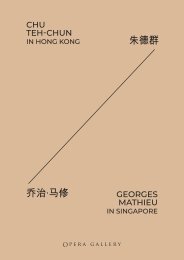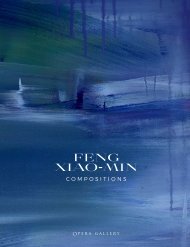George Morton-Clark - All Good And Make Believe
Create successful ePaper yourself
Turn your PDF publications into a flip-book with our unique Google optimized e-Paper software.
GEORGE<br />
MORTON-CLARK<br />
ALL GOOD AND<br />
MAKE BELIEVE
GEORGE<br />
MORTON-CLARK<br />
ALL GOOD AND<br />
MAKE BELIEVE<br />
8 - 22 October 2020
PRÉFACE<br />
PREFACE<br />
Pour sa première exposition personnelle parisienne, l’artiste britannique <strong>George</strong><br />
<strong>Morton</strong>-<strong>Clark</strong> nous dévoile un ensemble d’œuvres inédites. On retrouve les<br />
personnages de prédilection de l’artiste ainsi que son style si reconnaissable :<br />
Donald Duck, Mickey Mouse ou encore Bart Simpson se présentent comme des<br />
ébauches dont l’étude approfondie révèle un travail sur la ligne, le mouvement et<br />
la dissolution de la figure. Les visiteurs pourront également admirer une sélection<br />
de sculptures témoignant des nouvelles explorations du medium par l’artiste.<br />
Passionné par l’animation et les dessins, il débute des études d’animation à la Surrey<br />
Institute of Art and Design. Il prend alors très vite conscience du basculement<br />
de la réalisation traditionnelle de dessins animés vers le numérique et redirige<br />
ses études vers les Beaux-Arts. Le résultat est sans précédent : à travers ses<br />
personnages animés, évocateurs des esquisses de dessins d’animation, <strong>George</strong><br />
<strong>Morton</strong>-<strong>Clark</strong> suscite de nombreuses émotions et nous replonge soudainement<br />
dans notre enfance. Mickey, Pluto, ou encore la Panthère Rose sont ici convoqués<br />
sous les mêmes traits que dans les dessins animés mais avec une vitalité renouvelée.<br />
<strong>George</strong> <strong>Morton</strong>-<strong>Clark</strong> explore ce monde qu’il créé au-delà de notre enfance en<br />
redonnant à ces personnages un air nouveau. Si ses œuvres peuvent souligner les<br />
aspects les plus sombres de notre société actuelle, elles rassemblent et unissent les<br />
spectateurs les uns aux autres en les replongeant dans cette allégresse de l’enfance.<br />
Eternity Gallery est heureuse de faire découvrir cet artiste au public parisien,<br />
à travers cette exposition personnelle qui rassemble de nouvelles toiles<br />
mais également les toutes premières sculptures jamais réalisées par l’artiste.<br />
For his first solo exhibition in Paris, British artist <strong>George</strong> <strong>Morton</strong>-<strong>Clark</strong> unveils<br />
a series of new works. They show the artist’s favourite characters, as well as<br />
his unmistakeable style: Donald Duck, Mickey Mouse, and Bart Simpson seem<br />
to be drafts, but a closer study reveals careful work on the lines, movement<br />
and the dissolution of the character. Visitors will also be able to admire<br />
a selection of sculptures showing the artist’s exploration of a new medium.<br />
Passionate about animation and drawing, he began to study animation at<br />
Surrey Institute of Art and Design. He soon realised that the traditional<br />
manner of creating cartoons was shifting towards the digital medium,<br />
and decided to study fine arts instead. The result is unparalleled: with his<br />
cartoon characters that resemble sketches of cartoon drawings, <strong>George</strong><br />
<strong>Morton</strong>-<strong>Clark</strong> provokes a range of emotions and suddenly thrusts us back<br />
into childhood. Here, Garfield, Pluto, and the Pink Panther are depicted<br />
with the same features as in the cartoons, but they have a new vitality.<br />
<strong>George</strong> <strong>Morton</strong>-<strong>Clark</strong> explores the world he creates beyond our<br />
childhood by giving these characters a new look. While his works<br />
may emphasise the darkest aspects of today’s society, they gather<br />
and unite viewers by taking them back to the jubilation of childhood.<br />
Eternity Gallery is delighted to introduce the artist to a Parisian audience in this<br />
solo show that presents new works, as well as the artist’s very first sculptures.<br />
Alexandre Sarfati<br />
Directeur<br />
Eternity Gallery Miami<br />
Marie de Bettignies<br />
Directrice<br />
Eternity Gallery Paris<br />
Alexandre Sarfati<br />
Director<br />
Eternity Gallery Miami<br />
Marie de Bettignies<br />
Director<br />
Eternity Gallery Paris<br />
4 5
ENTRETIEN<br />
Vous avez étudié l’animation à<br />
l’université, qu’est-ce qui a inspiré le<br />
passage aux beaux-arts ? Comment<br />
s’est déroulée cette transition ?<br />
Ça n’a pas été difficile. L’animation ne me<br />
permettait pas d’avoir la liberté de créativité<br />
que je recherchais. Je n’ai jamais cessé de<br />
peindre, donc le changement s’est effectué<br />
naturellement pour moi. C’est ma passion<br />
pour les dessins animés qui m’a poussé à<br />
débuter des études dans l’animation. Après<br />
trois années, j’ai réalisé que même si j’aimais<br />
ça, ce n’était pas pour moi. Je me sentais<br />
beaucoup plus attiré par la technique de<br />
réalisation traditionnelle de l’animation et<br />
je voyais qu’elle passait très vite du côté du<br />
numérique. J’aime la liberté et le désordre<br />
que l’on peut créer avec des pinceaux et des<br />
toiles. L’immédiateté d’utiliser de la peinture<br />
sur une toile et de la voir dans la vie réelle,<br />
cela, vous ne le trouvez pas dans<br />
l’animation numérique.<br />
Comment votre expérience dans<br />
l’animation influence-t-elle votre travail<br />
aujourd’hui ?<br />
L’expérience de dessiner des milliers de<br />
cellules vous donne certainement beaucoup<br />
de pratique ! Mes compétences en dessin<br />
ont, j’en suis sûr, considérablement<br />
progressé pendant mes études. En<br />
animation, on utilise différents types de<br />
dessin, ce qui est très utile pour un peintre<br />
qui souhaite changer de style. L’expérience<br />
de ces premières années d’études m’a aussi<br />
appris à être patient.<br />
6<br />
Quelles sont les significations de vos<br />
personnages de dessins animés ? Ces<br />
significations sont-elles importantes<br />
dans votre processus de création ?<br />
Il y a un lien très nostalgique avec les<br />
dessins animés. Nous les regardons tous et<br />
nous grandissons avec eux dans nos années<br />
les plus riches. J’utilise ces images comme<br />
support pour créer des abstractions dans<br />
mon travail. Elles donnent immédiatement<br />
au spectateur un sens et un lien avec le<br />
tableau avant qu’il ne regarde le reste de<br />
l’image. Ces personnages me servent ainsi<br />
d’appât pour capturer le spectateur.<br />
Quelles sont les significations des<br />
titres dans vos œuvres ? Ont-ils<br />
une importance particulière dans la<br />
compréhension de votre œuvre par le<br />
spectateur ?<br />
Les titres que je trouve sont tirés de la vie<br />
quotidienne. Lorsque l’on discute avec<br />
quelqu’un, on emploie des expressions<br />
de manière désinvolte. Il m’arrive alors de<br />
mémoriser ces phrases et quand je trouve le<br />
bon tableau, je le fais correspondre à cellesci.<br />
Parfois, un titre me vient instantanément<br />
à l’esprit rien qu’en regardant le tableau.<br />
Réalisez-vous des notes ou des croquis<br />
avant de commencer vos peintures ?<br />
Savez-vous à l’avance ce que vous allez<br />
créer ?<br />
Non, pas le moins du monde. L’immédiateté<br />
de mon travail est très apparente. J’aime les<br />
erreurs que je fais et je les intègre dans mon<br />
travail. Certaines des meilleures peintures<br />
que j’ai faites sont le fruit d’erreurs. Je les<br />
utilise et suis ensuite la voie qui m’amène au<br />
résultat final. Cette manière de procéder me<br />
permet ainsi de me surprendre moi-même<br />
du résultat, cela donne aussi de la fraîcheur<br />
et une constante évolution à mon travail.<br />
Votre processus de création commencet-il<br />
par le choix d’un personnage de<br />
dessin animé particulier ?<br />
Parfois, mais rarement. Je commence par<br />
créer une peinture abstraite à l’arrière de<br />
ma toile puis je formule une image au<br />
premier plan.<br />
Attachez-vous autant d’importance au<br />
processus de création qu’au résultat<br />
final ?<br />
Oui, je pense que le processus créatif est<br />
très important. Ce n’est pas comme un<br />
interrupteur qu’on peut allumer lorsque l’on<br />
a besoin de créer. Plus je vieillis, mieux je<br />
comprends comment l’exploiter.<br />
Y a-t-il une place pour les accidents<br />
dans votre processus de travail ?<br />
Oui, c’est mon principal objectif dans<br />
chaque tableau. Sans accidents, vous suivez<br />
le même chemin et obtenez les mêmes<br />
résultats. C’est un élément crucial pour<br />
évoluer et trouver de nouveaux<br />
domaines à explorer.<br />
Avec quel mouvement ou type d’art<br />
vous identifiez-vous le plus ?<br />
Aucun, en fait. J’aime être inspiré par<br />
un large éventail d’artistes. Lorsque l’on<br />
écoute de la musique, un jour on a envie de<br />
musique légère, un autre jour on préfèrera<br />
une musique plus dynamique : c’est ainsi<br />
que j’évolue, tout dépend de mon humeur<br />
et de ce que je ressens ce jour-là.<br />
Dans vos futurs travaux, envisagez-vous<br />
d’utiliser un autre matériau ? Quel défi<br />
aimeriez-vous relever ?<br />
J’utilise toujours des matériaux et des<br />
supports différents. Dans mon atelier, il y a<br />
toutes les reliques passées des différents<br />
médiums que j’ai explorés. Il m’arrive parfois<br />
de revenir à un médium car il correspond<br />
mieux à l’idée que je peux avoir. En ce<br />
moment, j’utilise différents matériaux et je<br />
les couds ensemble. J’aime que mon travail<br />
ait un effet vieilli, mais avec une touche<br />
contemporaine. J’aime le contraste de<br />
cette idée.<br />
Pensez-vous vous réorienter vers<br />
des personnages d’animation plus<br />
contemporains, comme les personnages<br />
de Disney ou de Pixar ? Auraient-ils<br />
un sens différent de vos personnages<br />
actuels, qui proviennent pour la plupart<br />
de dessins animés ?<br />
Pour être honnête, je n’ai pas l’intention de<br />
choisir un quelconque type de personnage.<br />
J’utilise le personnage comme une forme<br />
abstraite pour véhiculer une image que<br />
je veux construire. Je trouve que plus le<br />
personnage est identifiable, plus la pièce<br />
sera nostalgique, et plus elle aura un attrait<br />
pour un large public.<br />
7
INTERVIEW<br />
You studied animation at university, what<br />
inspired the switch to fine art? What was<br />
that journey like?<br />
I found the switch very easy. With animation<br />
I did not have as much creative control as I<br />
wanted. I have always been a painter so the<br />
switch was not very hard for me. The reason I<br />
went into animation in the first place was my<br />
love for cartoons and anime. After studying<br />
for 3 years I realised even though I loved it,<br />
it was not for me. I was more drawn to the<br />
traditional practice of animation and I could<br />
see it was changing very fast to computers. I<br />
love the freedom and the mess you can make<br />
with brushes and canvas. The immediacy of<br />
using paint on a canvas and seeing it in real<br />
life, this you will not find in animation.<br />
How does your experience in animation<br />
influence the work you do now?<br />
The experience of drawing thousands upon<br />
thousands of cells definitely gives you a lot<br />
of practice! I am sure whilst I was doing my<br />
degree my drawing skills went up a notch!<br />
In animation, I would use different styles<br />
of drawing which comes in good use as a<br />
painter being able to switch up styles. I also<br />
learnt to be patient.<br />
What meanings do you think cartoon<br />
characters carry? Are those meanings<br />
important in your creative process?<br />
There is a very nostalgic connection to<br />
cartoons. We all see and grow up with them<br />
in our most informative years. I use these<br />
images as a vessel to create abstractions<br />
in my work. It gives the viewer already a<br />
meaning and a connection to the painting<br />
before they look at the rest of the picture.<br />
This is a hook to capture the viewer.<br />
What is the meaning of your works’ titles?<br />
Do they have a particular importance for<br />
the viewer’s understanding of your work?<br />
The titles I come up with are from everyday<br />
life. When having conversations with<br />
people you do not realise there are some<br />
great throwaway phrases that we constantly<br />
use on a daily basis. I store these phrases<br />
and then when I find the right painting I<br />
will match it to them. Sometimes a title will<br />
instantly come to me by just looking<br />
at the painting.<br />
Do you realise notes or sketches before<br />
starting your paintings? Do you know in<br />
advance what you’re going to create?<br />
No, not in the slightest. The immediacy of<br />
my work is very apparent. I love the mistakes<br />
I make and incorporate them into my work.<br />
Some of the best paintings I have done<br />
have come from mistakes. I will use these<br />
and then follow the path to the end result.<br />
This way, I too am surprised by the outcome<br />
and it creates a freshness to my work. So I<br />
am constantly evolving and falling in love<br />
with the craft on a daily basis.<br />
Does your creative process begin<br />
with the choice of a particular cartoon<br />
character?<br />
Sometimes, but rarely. I first start by creating<br />
an abstract painting with the background<br />
then formulating an image to the foreground.<br />
Do you attach as much importance<br />
to the creative process as to the final<br />
result?<br />
Yes, I think the creative process is massively<br />
important. It is not like a switch that can<br />
be turned on. As I get older the better I<br />
understand how to harness it. At the end of<br />
the day, it is the reason you have<br />
the final result.<br />
Is there room for accident in your working<br />
process?<br />
Yes, this is my main goal in every painting as<br />
without this you are treading the same path<br />
and getting the same results. It is a crucial<br />
part to growing and finding new areas<br />
to explore.<br />
What movement or type of art do you<br />
most identify with?<br />
None really. I like to be inspired by a whole<br />
spectrum of artists. It is like listening to music,<br />
somedays you want light music some days<br />
fast. It all depends on your mood and how I<br />
feel that day.<br />
In your future works, do you consider<br />
using another material? What challenge<br />
would you like to take up?<br />
I am always using different materials and<br />
mediums. In my studio, there are all the past<br />
relics of different mediums I have explored<br />
with. Sometimes I will go back to them as it<br />
will best suit an idea I have. At the moment<br />
I am using different materials and sewing<br />
them together. I like my work to have an<br />
aged effect but with a contemporary feel. I<br />
like the contrast of this idea.<br />
Do you think you're redirecting yourself<br />
towards more contemporary animated<br />
characters, such as Disney or Pixar<br />
characters? Would they have a different<br />
meaning from your current characters,<br />
which mostly come from cartoons?<br />
To be honest I do not set out to choose any<br />
type of character. I use the character as an<br />
abstract form to convey an image I want<br />
to build. I find the more identifiable the<br />
character, the more nostalgic the piece will<br />
be, and greater an appeal it will have to a<br />
large audience.<br />
8<br />
9
10
NOTES DE L’ARTISTE<br />
ARTIST’S STATEMENT<br />
Les deux sculptures <strong>All</strong> <strong>Good</strong> and <strong>Make</strong> <strong>Believe</strong> et Last Orders sont des modèles<br />
réalisés en béton de Donald Duck et Mickey Mouse. J’ai choisi ces deux<br />
personnages pour leur imagerie iconique.<br />
The two sculptures <strong>All</strong> <strong>Good</strong> and <strong>Make</strong> <strong>Believe</strong> and Last Orders are concrete<br />
models of Donald Duck and Mickey Mouse. I chose these two characters for<br />
their iconic imagery.<br />
Lors d’un voyage en Grèce à 19 ans, j’ai remarqué que de nombreux bâtiments en<br />
béton étaient inachevés, on pouvait encore voir les tiges de fer qui dépassaient<br />
des toits. J’ai appris plus tard qu’ils avaient été laissés comme cela pour des<br />
raisons fiscales. J’ai alors pensé que ce serait un bon concept à utiliser dans<br />
une sculpture. Le béton et les tiges de fer ont une relation architecturale<br />
entre eux.<br />
When I was traveling around Greece as a 19 year-old I noticed that many of<br />
the concrete buildings looked like they were unfinished and you could still<br />
see the iron rods sticking out from the roof tops. I later found out this was<br />
for tax purposes. I thought at the time that in some way this would be a good<br />
concept to use in a sculpture. The concrete and iron rods have an architectural<br />
relationship with each other.<br />
Après 20 ans, lorsque j’ai conçu ces sculptures, j’ai pensé que l’assemblage du<br />
béton avec les barres de fer rouillées correspondrait à l’esthétique recherchée<br />
et faciliterait la conception. L’idée était de faire de ces icônes du XXe siècle<br />
des sculptures industrielles pseudo-grecques, brutalistes, qui contrastent bien.<br />
Le béton et le mouvement leur donnent l’impression d’être figées, et coincées<br />
dans le temps. Les barres de fer se prêtent à la sculpture et à l’extension du<br />
mouvement ainsi que de la décomposition que je voulais créer.<br />
Fast forward nearly 20 years and when I was designing the sculptures I thought<br />
the concrete with the rusted iron bars would be perfect for the aesthetics<br />
and facilitate in the design. The idea of having these very bright 20th century<br />
icons made into pseudo Greek, Brutalist, industrial sculptures, which contrasts<br />
well. The concrete and the movement makes them seem as if they are frozen,<br />
and stuck in time. The iron bars lend themselves well to the sculpture and the<br />
extension of the movement and decay I wanted to create.<br />
Je leur ai donné un nom un peu ironique. Avec Last Orders, on a l’impression<br />
que Mickey se précipite au bar avant l’heure de fermeture, le titre <strong>All</strong> <strong>Good</strong> and<br />
<strong>Make</strong> <strong>Believe</strong> me permettait de faire une satire de notre monde actuel.<br />
I named them slightly tongue-in-cheek. Last Orders, because it looks like<br />
Mickey is rushing to the bar before closing time, and <strong>All</strong> <strong>Good</strong> and <strong>Make</strong> <strong>Believe</strong>,<br />
because I wanted to satirise the world at this moment.<br />
12<br />
13
Last Orders<br />
2020<br />
Concrete<br />
Edition of 8<br />
68 x 45 x 44 cm<br />
26.7 x 18 x 17.3 in<br />
Provenance<br />
Artist’s studio<br />
14
<strong>All</strong> <strong>Good</strong> <strong>And</strong> <strong>Make</strong> <strong>Believe</strong><br />
2020<br />
Concrete<br />
Edition of 8<br />
70 x 80 x 60 cm<br />
27.5 x 31.5 x 23.6 in<br />
Provenance<br />
Artist’s studio<br />
17
Can’t Find a <strong>Good</strong> Sharpie<br />
2020<br />
Charcoal, oil and spray paint on canvas<br />
150 x 102 cm<br />
59.1 x 40.2 in<br />
Provenance<br />
Artist’s studio<br />
18
Pink Penny<br />
2020<br />
Charcoal and dye on canvas<br />
170 x 150 cm<br />
66.9 x 59.1 in<br />
Provenance<br />
Artist’s studio<br />
20
Fruit Loops<br />
2020<br />
Charcoal and enamel on canvas<br />
170 x 150 cm<br />
66.9 x 59.1 in<br />
Provenance<br />
Artist’s studio<br />
23
Bad Mickey<br />
2020<br />
Charcoal on canvas<br />
120 x 150 cm<br />
47.2 x 59.1 in<br />
Provenance<br />
Artist’s studio<br />
25
White Dot/Black Dot<br />
2020<br />
Charcoal oil and spray paint on canvas<br />
170 x 150 cm<br />
66.9 x 59.1 in<br />
Provenance<br />
Artist’s studio<br />
26
Decaf Life<br />
2020<br />
Oil, spray paint, pencil and charcoal on canvas<br />
170 x 150 cm<br />
66.9 x 59.1 in<br />
Provenance<br />
Artist’s studio<br />
28
Jal Poppers No Dip<br />
2020<br />
Charcoal and acrylic on canvas<br />
110 x 85 cm<br />
43.3 x 33.5 in<br />
Provenance<br />
Artist’s studio<br />
31
Looking For That Market<br />
2020<br />
Charcoal, oil and spray paint on canvas<br />
105 x 85 cm<br />
41.3 x 33.5 in<br />
Untrustworthy<br />
2020<br />
Charcoal, oil and spray paint on canvas<br />
105 x 85 cm<br />
41.3 x 33.5 in<br />
Provenance<br />
Artist’s studio<br />
Provenance<br />
Artist’s studio<br />
32<br />
33
Last Dance Of The Evening<br />
2020<br />
Charcoal and enamel on canvas<br />
170 x 150 cm<br />
66.9 x 59.1 in<br />
Provenance<br />
Artist’s studio<br />
35
Trans-solution<br />
2020<br />
Charcoal, enamel and oil on canvas<br />
170 x 150 cm<br />
66.9 x 59.1 in<br />
Provenance<br />
Artist’s studio<br />
37
No Excess<br />
2020<br />
Charcoal, oil and spray paint on canvas<br />
170 x 150 cm<br />
66.9 x 59.1 in<br />
Provenance<br />
Artist’s studio<br />
38
Outsider Cliffhanger<br />
2020<br />
Charcoal, oil and spray paint on canvas<br />
170 x 150 cm<br />
66.9 x 59.1 in<br />
Provenance<br />
Artist’s studio<br />
40
Bad Donald<br />
2020<br />
Charcoal on canvas<br />
120 x 150 cm<br />
47.2 x 59.1 in<br />
Provenance<br />
Artist’s studio<br />
42
Last Dandelion Of The Season<br />
2020<br />
Charcoal, oil and spray paint on canvas<br />
115 x 85 cm<br />
45.3 x 33.5 in<br />
4.30am Riser<br />
2020<br />
Charcoal, oil and spray paint on canvas<br />
115 x 85 cm<br />
45.3 x 33.5 in<br />
Provenance<br />
Artist’s studio<br />
Provenance<br />
Artist’s studio<br />
44<br />
45
Re-enlisted Psycho<br />
2020<br />
Charcoal and acrylic on canvas<br />
110 x 85 cm<br />
43.3 x 33.5 in<br />
Provenance<br />
Artist’s studio<br />
46
Wolfie’s Fine<br />
2020<br />
Charcoal, spray paint and oil on canvas<br />
170 x 190 cm<br />
66.9 x 74.8 in<br />
Provenance<br />
Artist’s studio<br />
49
I’ve Abandoned Myself<br />
2020<br />
Oil, spray paint and charcoal on canvas<br />
170 x 150 cm<br />
66.9 x 59.1 in<br />
Provenance<br />
Artist’s studio<br />
50
BIOGRAPHIE<br />
BIOGRAPHY<br />
Né à Tooting au Royaume-Uni, <strong>George</strong> <strong>Morton</strong>-<br />
<strong>Clark</strong> utilise l’huile, l’acrylique et le fusain sur<br />
des toiles non apprêtées. En combinant des<br />
images de personnages de dessins animés et<br />
des couleurs fortes, ses dessins réalisés au trait<br />
sont plongés dans une atmosphère abstraite<br />
d’énergie et de vivacité.<br />
Après avoir étudié l’animation pendant 3 ans<br />
à la London University, il obtient sa licence<br />
au Surrey Institute of Art and Design. Il part<br />
ensuite poursuivre une carrière purement<br />
artistique, mais l’animation a laissé chez l’artiste<br />
une influence certaine.<br />
<strong>Morton</strong>-<strong>Clark</strong> dévoile une technique<br />
dynamique au travers d’une combinaison<br />
intéressante de trois éléments : des couleurs<br />
intenses, des dessins spontanés et des<br />
personnages de dessins animés nostalgiques.<br />
Son travail peut sembler simple au premier<br />
abord, une fusion de personnages de dessins<br />
animés et d’éléments abstraits, mais il y a<br />
quelque chose de saisissant au cœur de son<br />
œuvre. La riche imagination et la sensibilité<br />
de l’artiste s’y expriment librement ; il n’est<br />
pas limité par un seul genre, et toutes sortes<br />
de matériaux colorés inspirent naturellement<br />
leurs récits allégoriques à ceux qui regardent<br />
ses œuvres.<br />
<strong>Morton</strong>-<strong>Clark</strong> ajoute de l’originalité et une<br />
histoire à des personnages de dessins animés<br />
déjà familiers : ils renaissent avec un nouveau<br />
sens, une nouvelle vitalité. L’artiste se défend de<br />
toute complaisance et s’efforce constamment<br />
de faire évoluer son travail dans une nouvelle<br />
direction. C’est ainsi que son art devient un<br />
mélange de divers styles - des éléments<br />
abstraits se mêlant à des techniques figurative<br />
et expressionniste - qui s’ajoutent également<br />
à la diversité des personnages représentés<br />
dans son travail. <strong>Morton</strong>-<strong>Clark</strong> utilise la surface<br />
naturelle et non apprêtée de sa toile pour<br />
donner vie à des personnages connus tels que<br />
Mickey Mouse, Donald Duck ou Tom et Jerry. Ils<br />
sont dessinés de telle manière qu’ils incarnent<br />
à la fois le charme d’une toile terminée et celui<br />
d’une ébauche encore repensée. Les parties<br />
les plus chaotiques et exagérées de son travail<br />
sont elles aussi exprimées avec une franchise si<br />
naturelle qu’elles se transforment en éléments<br />
positifs, inspirant vitalité et vivacité.<br />
Ces personnages récurrents dans l’œuvre de<br />
<strong>George</strong> <strong>Morton</strong>-<strong>Clark</strong> nous fixent de leurs<br />
grands yeux depuis la toile, d’une manière<br />
frappante et accentuée. Leurs regards suffisent<br />
à évoquer une collection d’émotions, tout ce<br />
que nous ressentons et exprimons. On ne sait<br />
pas s’ils transmettent la surprise ou la peur, ou<br />
s’ils sont alors une représentation des yeux de<br />
l’artiste. Néanmoins, nous sommes plongés<br />
dans un état de curiosité auquel l’artiste répond<br />
avec une simplicité ambigüe. Son œuvre est<br />
tout simplement offerte au spectateur ; telle<br />
une fenêtre de détente et de plaisir simple que<br />
l’on peut utiliser pour rêver à notre guise.<br />
L’œuvre de <strong>Morton</strong>-<strong>Clark</strong>, très appréciée par<br />
le Dr Rolf Lauter, ancien conservateur en chef<br />
et directeur adjoint du Museum für Moderne<br />
Kunst de Francfort, en <strong>All</strong>emagne, respire<br />
l’humilité et la franchise : « Pour apprécier<br />
son travail comme il se doit, il faut saisir le<br />
contenu qui s’étale sur l’ensemble de la toile,<br />
non pas y chercher un sens caché. Plutôt que<br />
de présenter un grand thème élaboré sur<br />
notre époque, et d’essayer de s’intégrer dans<br />
une section de l’histoire de l’art, il présente<br />
des pièces qui ressemblent à des moments<br />
confortables et amusants passés à rire et à<br />
parler à des amis proches ».<br />
<strong>George</strong> <strong>Morton</strong>-<strong>Clark</strong>, a British artist, utilises<br />
oil, acrylic, and charcoal on unprimed canvas<br />
to bring familiar cartoon characters to life.<br />
With a combination of bold images and strong<br />
colours, his line drawings are immersed in an<br />
abstract atmosphere of energy and liveliness.<br />
After studying animation for 3 years at London<br />
University, he attended the Surrey Institute<br />
of Art and Design. Once he completed his<br />
Bachelor of Arts, he left to pursue a career in<br />
art but animation remained a strong influence<br />
in his craft.<br />
<strong>Morton</strong>-<strong>Clark</strong> guides us into his energetic<br />
work with an interesting combination of<br />
three elements: intense colours, spontaneous<br />
drawings, and nostalgic cartoon characters.<br />
His work may seem simple at first glance, just a<br />
straightforward fusion of cartoon characters and<br />
abstract components, yet something striking<br />
lies in the midst. The artist’s rich imagination<br />
and sensibility are freely expressed; he is not<br />
restricted by a single genre, and all kinds of<br />
colourful materials naturally communicate their<br />
allegorical stories to those viewing his work.<br />
He adds originality and story to already familiar<br />
cartoon characters, and through this, they are<br />
reborn with a newfound sense of vitality and<br />
meaning. He is wary of complacency and<br />
constantly strives to move his work in a new<br />
direction. This results in his art becoming a<br />
mixture of a variety of styles—abstract elements<br />
mingling with figurative, and expressionistic<br />
techniques also adding to the diversity<br />
represented in his work. <strong>Morton</strong>-<strong>Clark</strong> uses<br />
the natural, unprimed surface of his canvas as<br />
a place to bring well-known characters such<br />
as Mickey Mouse, Donald Duck, and Tom and<br />
Jerry, to life. They are drawn in such a way that<br />
embodies both the charm of a painting that is<br />
finished and one that is still in progress. Even<br />
the chaotic, exaggerated portions of his work<br />
are expressed with such a natural frankness that<br />
they are transformed into positive elements that<br />
inspire vitality and liveliness.<br />
Another element that catches the eye is the<br />
numerous characters that continuously make<br />
appearances in his paintings. Their large<br />
eyes stare at us from the canvas, in a striking<br />
and overemphasised fashion. Their gazes are<br />
enough to evoke a collection of emotions;<br />
everything we feel and express. Whether they<br />
are conveying surprise or fear, or if they are<br />
actually a representation of the artist’s eyes, is<br />
unsure. Nonetheless, we are engulfed in a state<br />
of curiosity which the artist responds to with an<br />
ambiguous simplicity. His artwork is simply a<br />
gift to the viewer; a small window of relaxation<br />
and simple enjoyment that the viewer can use<br />
to imagine to their heart’s content.<br />
<strong>Morton</strong>-<strong>Clark</strong>’s work, which has been highly<br />
praised by Dr. Rolf Lauter, former Chief<br />
Curator and Deputy Director of the Museum<br />
für Moderne Kunst in Frankfurt, Germany,<br />
emanates humility and candour: “To<br />
appreciate his work properly, one must take<br />
in the contents splayed upon the entirety of<br />
the canvas, instead of looking for a hidden<br />
meaning behind them. Rather than presenting<br />
a grand, elaborate theme about our time, and<br />
trying to integrate himself into some section of<br />
Art History, he presents pieces that resemble<br />
comfortable and fun times spent laughing and<br />
talking to close friends.”<br />
54<br />
55
Eternity Gallery would like to thank <strong>George</strong> <strong>Morton</strong>-<strong>Clark</strong> for his<br />
help and generosity that made this exhibition possible.<br />
Published by Eternity Gallery to coincide with the exhibition<br />
<strong>All</strong> <strong>Good</strong> <strong>And</strong> <strong>Make</strong> <strong>Believe</strong>, 8 - 22 October 2020.<br />
<strong>All</strong> rights reserved. Except for the purposes of review, no part of<br />
this e-catalogue may be reproduced, stored in a retrieval system,<br />
or transmitted, in any form or by any means, electronic, mechanical,<br />
photocopying, recording or otherwise, without the prior permission<br />
of the publishers.<br />
Cover: Can’t Find A <strong>Good</strong> Sharpie, 2020<br />
Second page: detail of <strong>All</strong> <strong>Good</strong> and <strong>Make</strong> <strong>Believe</strong>, 2020<br />
eternitygallery.com


